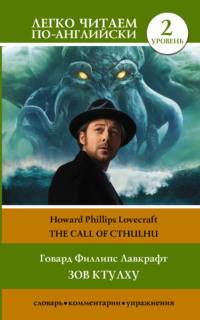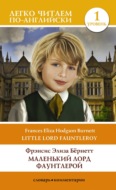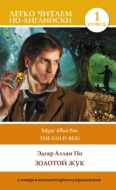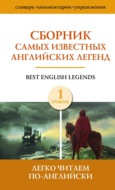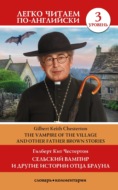Buch lesen: "Зов Ктулху / The Call of Cthulhu. Уровень 2"
© Матвеев С. А., адаптация, словарь, 2022
© ООО «Издательство АСТ», 2022
Howard Phillips Lovecraft
The Call of Cthulhu
I. The Horror In Clay
I think, that the most merciful thing in the world is the inability of the human mind to correlate all its contents. We live on a placid island of ignorance in the midst of infinite black seas. Will we voyage far? The sciences harmed us little; but some day the parts of dissociated knowledge will open up such terrifying views of reality, that we’ll go mad from the revelation. Or we’ll flee from the light into the peace and safety of a new dark age1.
Theosophists2 tell about awesome grandeur of the cosmic cycle where our world and human race form transient incidents. Their strange suggestions freeze the blood. When I think of them and when I dream of them, forbidden ages chill me and madden me. Like all dread glimpses of truth, that glimpse appeared from an accidental parts of separated things. In this case, from an old newspaper and the notes of a dead professor. I hope that no one else will collect those parts. Certainly, if I live, I will never add a link in that terrible chain. I think that the professor, too, intented to keep silent. He wanted to destroy his notes but sudden death stopped him.
My first knowledge of the theme began in the winter of 1926–1927 with the death of my great-uncle3, George Gammell Angell, Professor Emeritus of Semitic Languages4 in Brown University, Providence, Rhode Island. Professor Angell was widely known as an authority on ancient inscriptions. The heads of prominent museums frequently asked him for help. Everybody talked about his death at the age of ninety-two. Moreover, the obscurity of the cause of death intensified the interest. The professor was stricken while he was returning from the Newport boat5. He fell suddenly. Witnesses said that a nautical-looking Negro6 pushed him. That Negro came from one of the queer dark streets on the precipitous hillside. These streets formed a short way from the waterfront to the professor’s home in Williams Street. Physicians were unable to find any visible disorder. After perplexed debate they concluded that some obscure lesion of the heart was responsible for the end. The brisk ascent of a steep hill provoked that lesion. The professor was old. At the time I saw no reason to disagree with them, but lately I began to doubt.
My great-uncle’s died a childless widower. I was his heir and executor. I moved his files and boxes to my quarters in Boston to study his papers. The American Archaeological Society later published much of the material. But there was one box which I found very puzzling. I did not want to show this box to other eyes. It was locked and I did not find the key. But after I examined the personal ring which the professor carried in his pocket I was able to open it. When I did so I confronted another barrier. I found the queer clay bas-relief7
and the disjointed notes, ramblings, and cuttings. What was their meaning? Was my uncle, in his latter years, superstitious? I decided to find the eccentric sculptor which was responsible for this apparent disturbance of an old man’s mind.
The bas-relief was a rough rectangle less than an inch thick8 and about five by six inches in area. Obviously it was of modern origin. Its designs, however, were far from modern in atmosphere and suggestion. And there was writing of some kind. But I was unable to identify the letters.
Above hieroglyphics was a figure. It was not detailed but it conveyed an idea. It was a sort of monster, or symbol of a monster. Only a diseased fancy can conceive this form. My extravagant imagination offered simultaneous pictures of an octopus, a dragon, and a human caricature. The spirit of the sculpture combined all of them. A pulpy, tentacled head9 surmounted a grotesque and scaly body with rudimentary wings. The general outline of the whole monster was very shocking and frightful. Behind the figure was a vague Cyclopean architectural background10.
Professor Angell himself wrote some of the documents accompanying this thing. He made it recently; and made no pretense to literary style. The main document had the title “CTHULHU CULT”. The characters were painstakingly printed11 to avoid the erroneous reading of an unknown word. This manuscript was divided into two sections. The first section had the title “1925 – Dream and Dream Work of H.A. Wilcox, 7 Thomas St., Providence, R. I.12”. The second section had the title “Narrative of Inspector John R. Legrasse, 121 Bienville St., New Orleans, La., at 1908 A. A. S. Mtg. – Notes on Same, amp; Prof. Webb’s Acct.13” The other manuscript papers were brief notes. Some of these brief notes were the descriptions of the strange dreams of different persons. Some of them were citations from theosophical books and magazines (notably W. Scott-Elliot’s Atlantis and the Lost Lemuria14). The other notes were comments on secret societies and hidden cults, with references to passages in such mythological and anthropological books as Frazer’s Golden Bough15 and Miss Murray’s Witch-Cult in Western Europe16. The articles cut from papers were mainly about mental illness and outbreaks of group folly or mania in the spring of 1925.
The first half of the principal manuscript told a very interesting tale. On March 1st, 1925, a thin, dark young man came to Professor Angell. He was nervous and excited and bearing the singular clay bas-relief. That bas-relief was exceedingly damp and fresh. His card bore the name of Henry Anthony Wilcox. My uncle had recognized him as the youngest son of an excellent family. He knew that family a little.
The young man was studying sculpture at the Rhode Island School of Design17. He was living alone at the Fleur-de-Lys Building near that institution. Wilcox was a precocious young genius with great eccentricity. When he was a child he liked strange stories and odd dreams. He liked to relate them, too. He called himself “psychically hypersensitive18”, but the people of the ancient commercial city called him “queer.” He disappeared gradually from social visibility, and was now known only to a small group of esthetes from other towns. Even the Providence Art Club19, that was trying to preserve its conservatism, found him quite hopeless.
What did the professor’s manuscript tell about the cause of the visit? The sculptor abruptly asked to help him identify the hieroglyphics of the bas-relief. He spoke in a dreamy, stilted manner which suggested pride and alienated from him. My uncle’s reply was quite sharp. The conspicuous freshness of the tablet did not show any relation to archaeology. Young Wilcox’s answer impressed my uncle. It was of a fantastically poetic nature.
He said, “It is new, indeed. I made it last night in a dream of strange cities. These dreams are older than brooding Tyre, or the contemplative Sphinx, or garden-girdled Babylon20.”
Then he began to tell his tale. The story suddenly won the interest of my uncle because it woke something in his memory. There was a slight earthquake tremor the night before, the most considerable in New England for some years. It affected Wilcox’s imagination greatly. He had an unprecedented dream of great Cyclopean cities of Titan blocks and sky-flung monoliths21. They all were dripping with green ooze and sinister with latent horror. Hieroglyphics covered the walls and pillars. From some undetermined point below came a voice that was not a voice. It was a chaotic sensation which only fancy transmuted into sound. He attempted to replicate it by the almost unpronounceable combination of letters: “Cthulhu fhtagn.”
This strange phrase was the key to the recollection which excited and disturbed Professor Angell. He questioned the sculptor with scientific interest. Then he studied with the great interest the bas-relief which the young man made. He did it half-dreaming and clad only in his night clothes. Wilcox afterwards said that my uncle blamed his old age, because he did not recognize hieroglyphics and pictorial designs fast enough. Many of his questions seemed highly inappropriate to his visitor, especially those which tried to connect the things with strange cults or societies. Wilcox did not understand the promises of silence, which professor offered him in exchange for an admission of membership in some widespread mystical or paganly religious society.
Professor Angell became convinced that the sculptor was indeed ignorant of any cult or system of cryptic lore. So he asked his visitor to supply him with future reports of dreams. This bore regular fruit. After the first interview the manuscript records daily visits of the young man. During these visits he related shocking fragments of nocturnal imaginery. He was always talking about some terrible Cyclopean pictures of dark and dripping stone, with a subterrene voice or intelligence shouting monotonously enigmatical uninscribable gibberish22. The two sounds were frequently repeated are rendered by the letters “Cthulhu” and “R’lyeh.”
The manuscript continued. On March 23, Wilcox did not come. He was ill with an obscure fever. They took him to the home of his family in Waterman Street. He cried out in the night, and arouse several other artists in the building. He showed since then only alternations of unconsciousness and delirium. My uncle at once telephoned the family. From that time he watched the case closely. He was calling often at the Thayer Street office of Dr. Tobey who treated Wilcox. The young man’s febrile mind, apparently, was dwelling on strange things. The doctor was shuddering as he spoke of them. They included not only a repetition of his former dreams. They also concerned gigantic things “miles high” which walked or lumbered about.
He never fully described these objects. He used occasional frantic words. After Dr. Tobey repeated them, the professor was convinced that they were identical with the nameless monster. This monster Wilcox tried to depict in his dream-sculpture. Reference to this object, the doctor added, was invariably a prelude to the young man’s lethargy. His temperature was quite normal. It was strange, indeed. But the whole condition was rather like true fever and not a mental disorder.
On April 2 at about 3 P.M. every trace of Wilcox’s illness suddenly ceased. He sat upright in bed. He was surprised to find himself at home. He was completely ignorant of what happened in dream or reality since the night of March 22. His physician declared that he recovered and he returned to his quarters in three days. But he was not able to help Professor Angell. All traces of strange dreaming vanished with his recovery. My uncle kept no record of his night-thoughts after a week of pointless and irrelevant descriptions of usual visions.
Here the first part of the manuscript ended. But the references to different notes gave me much material for thought. The notes were the descriptions of the dreams of various persons. They were covering the same period as that in which young Wilcox made his strange visits. It seems that my uncle was inquiring amongst nearly all the friends whom he was able to ask. He was asking for nightly reports of their dreams, and the dates of any notable visions for some time past. He received so many responses, that it seemed impossible to handle them without a secretary. This original correspondence was not preserved. But his notes formed a thorough and really significant digest. Average people in society and business gave an almost completely negative result. But sometimes they mentioned some formless nocturnal impressions, between March 23 and April 2. This was the period of young Wilcox’s delirium. Four cases of scientific men gave vague descriptions of strange landscapes. In one case there was mentioned a dread of something abnormal.
The answers of artists and poets were more interesting. I suspect that if we decide to compare the notes there will be some panic. But the original letters were absent. So I suspected that there were some leading questions23, or somebody edited the correspondence. That is why I continued to feel that Wilcox was deceiving the old scientist. The responses from esthetes told disturbing tale. From February 28 to April 2 many of them dreamed very bizarre things. The intensity of the dreams was immeasurably stronger during the period of the sculptor’s delirium. Over a fourth of them24 reported scenes and half-sounds like those which Wilcox described. Some of the dreamers were afraid of the gigantic nameless thing which became visible at the end. One case was very sad. A widely known architect had great interest toward theosophy and occultism. He went violently insane on the date of young Wilcox’s seizure. He died after continuously screaming for several months, asking for help. He wanted to be saved from some escaped denizen of hell. My uncle did not mention their real names, so I was unable do personal investigation. I traced down only a few so I was unable to make personal investigation myself. And it is well that no explanation ever reached those people.
The cuttings from newspaper’ articles were about cases of panic, mania, and eccentricity during that period. Professor Angell’s collection was tremendous, probably he hired a cutting bureau25. The sources were scattered throughout the globe. Here was a nocturnal suicide in London, where a man leaped from a window after a shocking cry. Here was a letter to the editor of a newspaper in South America, where a fanatic pretold future from his visions. An article from California described a theosophist colony. People in white robes were preparing for some “glorious fulfillment” which never arrived. Articles from India spoke of serious native unrest toward the end of March 22–23.
The west of Ireland, too, was full of wild rumour and legendary stories. A fantastic painter named Ardois-Bonnot offered a blasphemous Dream Landscape in the Paris spring salon of 1926. The recorded troubles in insane asylums were very numerous. And it is a miracle that nobody found something common in them. Then I was rationalistic, so I set them aside. Now I am simply unable to do so. But I was then convinced that young Wilcox knew of the older matters mentioned by the professor.
II. The Tale of Inspector Legrasse
The older matters made the sculptor’s dream and bas-relief significant to my uncle. They formed the second half of his long manuscript. Once before, it appears, Professor Angell saw the hellish outlines of the nameless monstrosity. Once before he thought about the unknown hieroglyphics, and heard the ominous syllables which can be written only as “Cthulhu”. And the horrible connection that he discovered made him ask young Wilcox about his dreams.
It was in 1908, seventeen years before, when the American Archaeological Society held its annual meeting in St. Louis. Professor Angell, because of his authority and knowledge, had a prominent part in all the meetings. And some outsiders offered him questions for correct answering and problems for expert solution.
There was between them a middle-aged man who travelled all the way from New Orleans to get special information. He was unable to get it from any local source. His name was John Raymond Legrasse. He was an Inspector of Police and he brought the subject of his visit with him. It was a grotesque, repulsive, and apparently very ancient stone statuette. Its origin was unknown.
Inspector Legrasse was not interested in archaeology at all. He came because of purely professional considerations. The statuette, idol, fetish, or whatever it was, was captured some months before in the wooded swamps south of New Orleans during a raid on a supposed voodoo meeting26. The rites connected with it were so singular and hideous, that the police immediately realized that it was a dark cult totally unknown to them, and infinitely more diabolic than even the blackest of the African voodoo circles. Absolutely nothing was discovered of its origin. They discovered only erratic and unbelievable tales from the captured members. Hence the police asked for help from scholars. They wanted to identify the frightful symbol, and through it understand the cult itself.
Inspector Legrasse was not prepared for the sensation which his offering created. One sight of the thing was enough to throw the assembled scientists into a state of tense excitement. They crowded around him to gaze at the diminutive strange figure. The figure was apparently very old and nothing alike. An unknown school of sculpture made this terrible object. Centuries and even thousands of years were recorded in its dim and greenish surface of stone.
They passed slowly this figure from man to man for close and careful study. It was between seven and eight inches in height. It represented a vaguely humanoid monster, with an octopus-like head. Its face was a mass of feelers. It had a scaly rubbery-looking body, prodigious claws on hind and fore feet, and long, narrow wings behind. This thing was an embodiment of a fearsome and unnatural malignancy27. It squatted evilly on a rectangular block or pedestal that was covered with undecipherable characters28. The tips of the wings touched the back edge of the block. The seat occupied the center. The long, curved claws of the hind legs gripped the front edge and extended toward the bottom of the pedestal. The cephalopod head29 was bent forward. The ends of the facial feelers brushed the backs of huge fore paws which clasped the elevated knees. The creature looked abnormally life-like and fearful. Its source was totally unknown. Its vast, awesome, and incalculable age was unmistakable. But it was not connected to any known type of art belonging to civilisation’s youth – or indeed to any other time. Even its material was a mystery. The soapy, greenish-black stone with its golden or iridescent flecks and striations was not familiar to geology or mineralogy. The characters along the base were totally unknown. Nobody had the least notion of even their remotest linguistic kinship. They, like the subject and material, belonged to something horribly remote and distinct from mankind as we know it.
The members shook their heads and confessed defeat at the Inspector’s problem. Yet there was one man in that gathering who recognized bizarre familiarity in the monstrous shape and writing. This person was the late William Channing Webb30, Professor of Anthropology in Princeton University, and a famous explorer.
Professor Webb took part, forty-eight years before, in a tour of Greenland and Iceland in search of some Runic inscriptions. On the West Greenland coast he met a singular tribe or cult of degenerate Esquimaux31. Their religion was a curious form of devil-worship. It frightened him with its deliberate bloodthirstiness32 and repulsiveness. It was a faith of which other Esquimaux knew little. They mentioned it only with shudders. They said that it came down from horribly ancient ages before the creation of the world. Besides nameless rites and human sacrifices there were certain queer hereditary rituals. These rituals addressed to a supreme elder devil ortornasuk33. Professor Webb took a careful phonetic copy of this from an agedangekok or wizard-priest34. It was expressing the sounds in Roman letters as best he knew how. The most important thing was the fetish, around which they danced when the aurora leaped high35 over the ice cliffs. The professor stated that it was a very crude bas-relief of stone. It was comprising a hideous picture and some cryptic writing. And it was a rough parallel in all essential features of the bestial thing which was now lying before the meeting.
The assembled members received information with suspense and astonishment. It was even more exciting to Inspector Legrasse. He began at once to question his informant. He noted and copied an oral ritual among the swamp cult-worshippers which his men arrested. So he asked the professor to remember the syllables from the diabolist Esquimaux. There then followed an exhaustive comparison of details and a moment of silence. Both detective and scientist agreed on the identity of the phrase common to two hellish rituals. Both the Esquimaux wizards and the Louisiana swamp-priests chanted to their kindred idols strange words. They were something like this:
“Ph’nglui mglw’nafh Cthulhu R’lyeh wgah’nagl fhtagn.”
Legrasse said that some his mongrel prisoners told him the meaning of these words. This text meant:
“In his house at R’lyeh dead Cthulhu waits dreaming36.”
And now Inspector Legrasse related his experience with the swamp worshippers. This is the story to which my uncle attached profound significance. It was the wildest dream of a myth-maker or a theosophist.
On November 1st, 1907, some frantic summons came to the New Orleans police from the swamp and lagoon country to the south. The people there are mostly primitive but good-natured descendants of Lafitte’s men37. They were in stark terror from an unknown thing which occurred in the night.
It was voodoo, apparently, but voodoo of the most terrible sort. Since the malevolent tom-tom38 began its incessant beating, some of their women and children disappeared. The sounds came from the black haunted woods where no one walked. There were insane shouts and harrowing screams, soul-chilling chants and dancing devil-flames. The frightened messenger added that it was impossible to stand that.
So twenty police officers in two carriages and an automobile went there. The shivering squatter was their guide. At the end of the road they walked for miles in silence through the terrible cypress woods where day never came. Ugly roots and malignant hanging nooses of Spanish moss beset them. Finally, they saw the squatter settlement, a miserable huddle of huts. Hysterical dwellers ran out to meet them. The policemen heard the beat of tom-toms now. It was far, far ahead; and a curdling shriek came when the wind shifted. The dim red light was visible through the forrest. The squatters refused to go toward the scene of unholy worship. Inspector Legrasse and his nineteen colleagues went into black arcades of horror.
They entered that region of traditionally evil repute. White men normally did not enter it. There were legends of a hidden lake, in which dwelt a huge, formless white polypous animal with luminous eyes. Squatters whispered that bat-winged devils flew up out of caverns in inner earth to worship it at midnight. It was there before the Indians, and before even the beasts and birds of the woods. It was nightmare itself, and to see it was to die. But it was coming to people in dreams, and so they knew enough not to go there. The present voodoo orgy was, indeed, on the fringe of this area. But even that location was bad enough. Perhaps the very place of the worship terrified the squatters more than the shocking sounds and incidents.
Legrasse’s men went on through the black swamp toward the red glare and muffled tom-toms. There are sounds made by men, and sounds made by beasts and was terrible their dreadful combination. The policemen heard howls of animal fury and orgiastic ecstasy. The voices were like pestilential tempests from the gulfs of hell. From time to time the sounds ceased and a chorus of hoarse voices chanted that hideous phrase or ritual:
“Ph’nglui mglw’nafh Cthulhu R’lyeh wgah’nagl fhtagn.”
Then the men reached a spot where the trees were thinner. Four of them reeled, one fainted, and two cried frantically. Legrasse splashed some water in the face of the fainted man. They stood there, trembling and nearly hypnotized with horror.
In a natural glade of the swamp stood a grassy island. The island was of an acre’s extent, clear of trees and dry. On this now leaped and twisted indescribable horde of humans. They were totally naked. This hybrid spawn were braying, bellowing, and writhing about a monstrous ring-shaped bonfire. In the centre stood a great granite monolith some eight feet in height. On top of this great granite monolith rested the noxious carven statuette. Ten scaffolds were set up at regular intervals, forming a circle. From them hung, head downward, the marred bodies of the helpless disappeared squatters. Inside this circle the ring of worshippers jumped and roared. They were moving from left to right in endless dance between the ring of bodies and the ring of fire.
It may be only imagination, but one of policemen, a Spanish man, heard antiphonal responses to the ritual from some far and unillumined spot within the wood. I later met and questioned this man, Joseph D. Galvez. He said that he heard beating of great wings. He saw a glimpse of shining eyes and a mountainous white bulk beyond the remotest trees. I suppose he was a little superstitious.
But duty came first. The police relied on their firearms and went determinedly into the nauseous rout. For five minutes the chaos was beyond description. Blows were struck, shots were fired, and escapes were made. In the end Legrasse counted forty-seven sullen prisoners. He ordered to dress them and fall into line between two rows of policemen. Five of the worshippers lay dead, and two were severely wounded. Of course, Legrasse took the statuette from the monolith.
After an exhausting trip, the prisoners were examined. They were men of a very low, mixed-blooded, and mentally aberrant type39. Most were seamen, some Negroes and mulattoes, largely West Indians or Portuguese from the Cape Verde Islands40. This cult and its members looked like connected to voodooism. But before many questions, it became clear that something far deeper and older than Negro fetishism was involved.
They worshipped, so they said, the Great Old Ones41 who lived ages before there were any men. The Great Old Ones came to the young world out of the sky. Those Old Ones were gone now, inside the earth and under the sea. Their dead bodies told their secrets in dreams to the first men, who formed a cult which never died. This was that cult. It always existed and will always exist. It is hidden in distant and dark places all over the world. The time will come when the great priest Cthulhu, from his dark house in the mighty city of R’lyeh under the waters will rise and rule the earth. Some day, when the stars are ready, he will call. The secret cult will always wait to liberate him.
They refused to tell more. There was a secret and it was impossible to extract it. Mankind was not absolutely alone among the conscious things of earth. Some shapes came out of the dark to visit the faithful few42. But these were not the Great Old Ones. No man saw the Old Ones. The carven idol was great Cthulhu, but nobody can say how the others look like. No one was able to read the old writing now. The things were told by word of mouth. The chanted ritual was not the secret. The chant meant only this:
“In his house at R’lyeh dead Cthulhu waits dreaming.43”
Only two of the prisoners were found sane enough to hang them. The rest were taken to various hospitals. All denied ritual murders, and said that the killing was done by Black Winged Ones44 which came to them from their immemorial meeting-place in the haunted wood. But nobody wanted to talk about these mysterious allies. What the police learned, came mainly from the very old mestizo named Castro45. Castro sailed to different ports and talked with undying leaders of the cult in the mountains of China.
Old Castro remembered bits of hideous legend that made man and the world seem recent and transient indeed. There were ages when other Creatures ruled on the earth and They had great cities. The deathless Chinamen told him that remains of Them can still be found as Cyclopean stones on islands in the Pacific46. They all died long ago before men came. But it is possible to revive Them when the stars came round again to the right positions in the cycle of eternity. They came themselves from the stars, and brought Their images with Them.
These Great Old Ones, Castro continued, were not composed altogether of flesh and blood. They had shape but that shape was not made of matter. When the stars were right47, They could travel from world to world through the sky. When the stars were wrong, They did not live.
But although They no longer lived, They never really died.
They all lie in stone houses in Their great city of R’lyeh, preserved by the spells of mighty Cthulhu for a glorious resurrection when the stars and the earth once again are ready for Them. But at that time some force from outside must serve to liberate Their bodies. The spells prevent Them from an initial move. They can only lie awake in the dark and think while millions of years pass by. They know all that is occurring in the universe. Their mode of speech is transmitted thought. Even now They talked in Their tombs. When, after infinities of chaos, the first men came, the Great Old Ones spoke to the sensitive among them forming their dreams. Only thus could Their language reach the fleshly minds.
Then, whispered Castro, those first men formed the cult around tall idols which the Great Ones showed them. Idols were brought in dim eras from dark stars. That cult will never die till the stars come right again. The secret priests will take great Cthulhu from His tomb to revive His servants and resume His rule of earth. It will be easy to know this time has come. Mankind will become as the Great Old Ones; free and wild and beyond good and evil. The people will throw aside laws and morals. And all men will shout and kill and revel in joy. Then the liberated Old Ones will teach them new ways to shout and kill and revel and enjoy themselves. All the earth will flame with a great fire of ecstasy and freedom. Meanwhile the cult, by appropriate rites, must keep alive the memory of those ancient ways and tell about their return.
